
Route 20, which connects Oregon and Massachusetts across 3,365 miles, is more than the country’s longest road. It’s also one of the most scenic—take its 90-mile stretch along New York’s Finger Lakes region as proof.
On the drive from Avon (one hour east of Buffalo) to Cardiff (just south of Syracuse) you’ll experience an array of glacier-carved marvels. Ice-age remnants range from deep gorges and soaring waterfalls to the region’s main attraction: 11 long slivers of lakes that look like a cat got hold of New York’s topo map. The longest scratch of a lake, Cayuga, reaches 38 miles in length, while neighboring Seneca is more than 600 miles deep, one of the deepest lakes in the country.
U.S. Route 20 links the northern portion of these lakes with offshoot adventure destinations, including Letchworth State Park, dubbed the Grand Canyon of the East, and birding oasis Montezuma National Wildlife Refuge, a stopover on the Atlantic-flyway migration route. Long-distance treks, like the 580-mile Finger Lakes Trail, connect glacier-etched sites like Buttermilk Falls in Ithaca and a 400-foot-deep gorge in Watkins Glen State Park. The trail also links hikers with the newly developed 750-mile Empire State Trail, a sideways-T-shaped route connecting New York City, Buffalo, Albany, and Rouses Point on the state’s Canadian border. For cyclists, it’s hard to beat riding by vineyards and lake views along the 78-mile Seneca Lake Loop. And more than 100 wineries, breweries, and distilleries across the region make for plenty of après-adventure choices.
Bookmark the following nine places for the best Finger Lakes outdoor experiences; all are located within a 45-minute drive of Route 20.
The Adventure Stops
Stop 1: Letchworth State Park
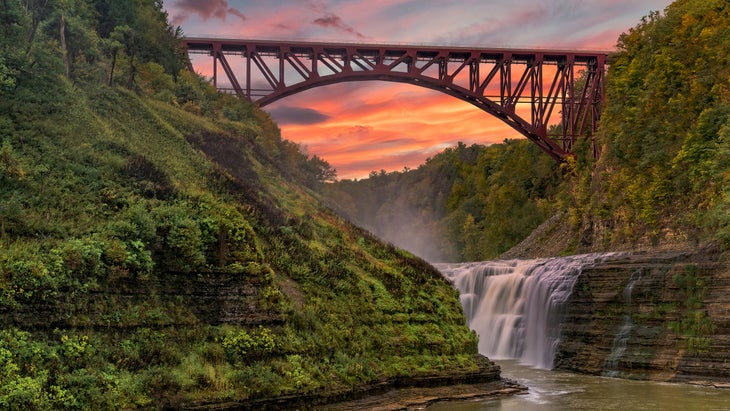
Dramatic Letchworth State Park is a 14,350-acre geology lesson. Its roaring Genesee River winds through a skyscraper-high gorge. The river’s main allure? Three colossal waterfalls: Lower, Middle, and Upper Genesee Falls. Water from the tallest of the three, Middle Falls, plunges more than 100 feet. After a solid rainfall, dozens of smaller falls also trickle throughout the park.
Of Letchworth State Park’s 20 marked trails, yellow-blaze Gorge Trail is the most scenic. This 14-mile round-trip jaunt follows the Genesee River gorge, with numerous canyon and waterfall overlooks along the way. The park is the best connection point to the multipurpose Empire State Trail, a 75 percent off-road route that links 27 New York counties across 750 miles. The trail, which opened last December, joins up with Letchworth State Park via the 90-mile Genesee Valley Greenway. And the region’s own thru-hike, the 580-mile Finger Lakes Trail, weaves through the park on its way to New York state’s next major outdoor hub: the Catskills.
Hiking isn’t the only way to soak up the park’s grand scenery. Local tour operator Adventure Calls Outfitters leads seasonal whitewater rafting excursions on the Genesee River’s Class I and Class II rapids (from $45).
Need to know: Letchworth State Park’s main entrances require a $10 fee, but the Parade Grounds and Mount Morris Dam and Recreation Area entrances are free. Cabin and campsite rentals can be found along the west side of the park.
Getting here: When heading east from Buffalo along U.S. Route 20, take a right onto New York 63, then meander down along New York 246 South and New York 39 West to reach the Letchworth State Park Portageville entrance. This is the southern terminus of the Gorge Trail. Park in the small lot just before the railroad bridge; the trail will be across the street from the lot.
Stop 2: Bristol Mountain Ski Resort and Aerial Adventure Park
Most people think of the Adirondacks or Catskills when it comes to skiing in New York State, but the Finger Lakes region impresses with its own hill: Bristol Mountain Ski Resort (day pass from $66 for adults). This powder-packed getaway boasts 1,200 vertical feet—the highest between the Adirondacks and the Rocky Mountains—with 38 slopes and trails and 140 acres of skiable terrain. The resort keeps 97 percent of the trails lit for nighttime runs; its powerful snow-making machine dusts the entirety of the mountain.
Even in the off-season, Bristol Mountain keeps the adventure alive. Bristol Mountain Aerial Adventures has family-friendly attractions like a zip-line canopy tour that spans 5,000 feet and a densely forested adventure park with tightropes, bridges, zip lines, and rope ladders.
Need to know: For slope-side lodging, book a North Star Village townhouse. These getaways come with full kitchens, fireplaces, and quick resort access. (Bristol Mountain itself does not offer accommodations.)
Getting here: Bristol Mountain is a 50-minute drive from Letchworth State Park. From the park, head north on Interstate 390, east on Route 20, then south to Bristol Mountain Ski Resort on New York 64/ U.S. 20A West just after Other Half Brewing Company. The resort will be on your right after about ten miles. For Bristol Mountain Aerial Adventures, take the same right onto U.S. 20A West, then turn right to continue along U.S. 20A West before reaching the entrance on South Hill Road.
Stop 3: Geneva Bike Trails
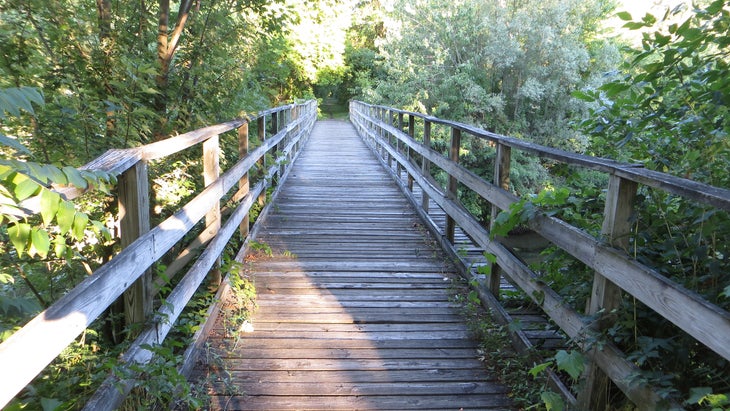
The quaint and colorful town of Geneva, on Seneca Lake’s northern end, is the ideal base camp for the area’s bike-trail network. The Cayuga-Seneca Canal Trail starts in Seneca Lake State Park, half a mile east of Geneva, and runs northeast along an old railroad and canal to the town of Waterloo. It’s currently seven miles long, but the local trail association envisions it spanning 19 miles—ending at Montezuma National Wildlife Refuge—when complete. From there it will connect with the 365-mile Erie Canalway Trail, a mostly off-road multipurpose trail that follows the Erie Canal.
Geneva is also the starting point of the long-distance Seneca Lake Loop, a 78-mile bike trail that flanks its namesake lake. If you’re looking to explore the region’s most bucolic side, opt for the 33-mile Around the Farm Trail instead, which also starts in Geneva and leads road cyclists across rolling hills through the Finger Lakes’ lush farming landscapes.
For bike rentals, Long Pier Ice Cream and Rentals on the lakefront has a handful of hybrid bikes available by the hour.
Need to know: Seneca Lake is ideal for half-day or full-day rides, but central New York’s best biking adventure runs just east of the Finger Lakes. The 235-mile Triple Divide Trail System is a mixed-surface path that connects Rochester and central Pennsylvania. Interested in a bikepacking expedition? Be sure to opt for wide mountain-bike tires.
Getting here: It’s a 40-minute drive from Bristol Mountain to downtown Geneva. From Bristol Mountain, take New York 64 north to rejoin Route 20. Head east 17 miles, then Route 20 will intersect with downtown Geneva. Long Pier Ice Cream and Rentals is just off to the right via Elizabeth Blackwell Street. Follow Route 20 to reach Seneca Lake State Park, the starting point of the Cayuga-Seneca Canal Trail. The Around the Farm Trail starts on Geneva’s Main Street, which intersects with Route 20 as well.
Stop 4: Watkins Glen State Park
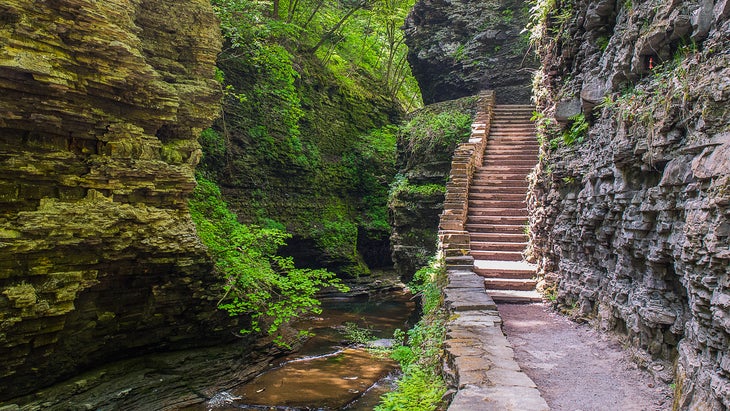
Waterfalls plunge at nearly every turn in Watkins Glen State Park, with 19 of them cascading down Paleozoic-era sedimentary rock. The Gorge Trail traverses through the thick of it. This route, open from late spring to late fall, packs in 832 stone steps, has sections that duck under Rainbow Falls and the Cavern Cascade, and features an 85-foot-high suspension bridge—all in a quick 1.5 miles.
During the summer, the park operates an Olympic-size swimming pool. Come winter, its 778 acres turn into a snowshoe and cross-country-ski wonderland.
Need to know: Watkins Glen State Park is also one of the Finger Lakes’ best camping getaways, with more than 300 campsites, including several RV- and pet-friendly spots.
Getting here: Geneva to Watkins Glen State Park is a straight shot down State Route 14/Main Street. Drive 45 minutes south before reaching the state-park entrance on Pine Street. This entrance leads to a parking lot; a walkway from the lot drops you at the start of the Gorge Trail.
Stop 5: Finger Lakes National Forest
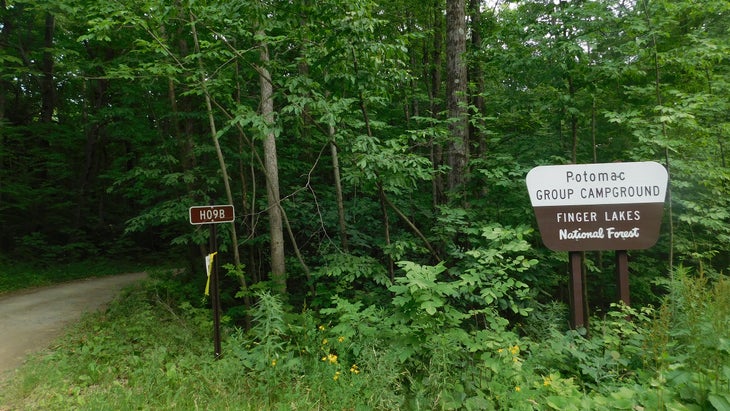
With 30 trail miles that cut through thick woodlands and labyrinthine gorges, the 16,000-acre Finger Lakes National Forest is among central New York’s best wilderness destinations. Beavers, bobcats, and red foxes call this forest home, as do free-ranging cattle, a feat made possible through the National Forest Service’s pasture-rental options for farmers.
The four-mile Burnt Hill Loop is the best way to see this pastoral blend of forest, cow pastures, and bird’s-eye vantage points. The aforementioned Finger Lakes Trail also passes through, as does the 12-mile Interloken Trail, an offshoot of the FLT that travels the length of the forest, passing small lakes, ponds, and grazing cows along the way.
Beyond hiking trails, you’ll find five acres of blueberry orchards, where you can pick your own fruit come summer.
Need to know: Camping is free throughout Finger Lakes National Forest, with three developed campgrounds and primitive campsites and shelters.
Getting here: The drive between Watkins Glen State Park and Finger Lakes National Forest’s main parking lot at Blueberry Patch Campground takes 20 minutes (it’s just over ten miles). Join New York 414 North then New York 79 East before catching County Road 4 and heading east for another five miles. After that, turn right on Picnic Area Road to reach the Blueberry Patch Campground parking lot.
Stop 6: Taughannock Falls State Park
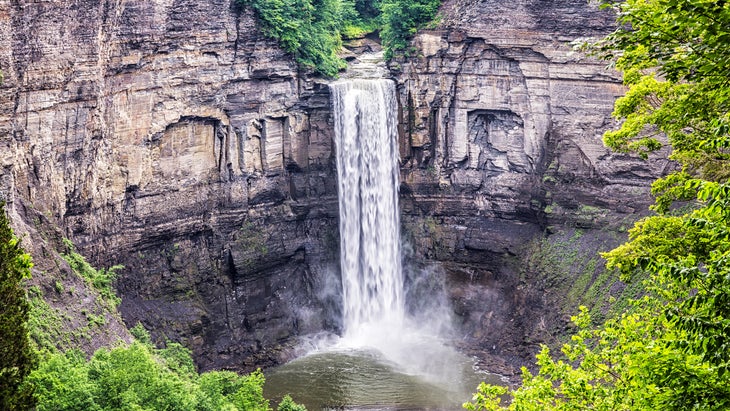
The waterfall wonders continue at Taughannock Falls State Park. Its namesake cascade, which is 33 feet taller than Niagara Falls, sends water tumbling through 400-foot-tall cliffs of sandstone, shale, and limestone. It’s best viewed from the Rim Trail Loop, a 2.7-mile path along the park’s north and south edges. The easier three-quarter-mile Gorge Trail ends with a viewing deck at the waterfall’s base.
Set on the shores of Cayuga Lake, the park is also a popular paddling destination. Canoe, kayak, and paddleboard rentals are available on park grounds through Paddle-N-More. Snowy winters bring a host of new adventures to the park, from cross-country skiing to sledding, and, if it’s cold enough, skating on frozen ponds.
Need to know: The bottom half of the South Rim Trail and the North Rim Trail’s stairs are closed during winter due to slippery conditions. Taughannock Falls State Park offers camping near Cayuga Lake; reservations are recommended.
Getting here: Finger Lakes National Forest and Taughannock Falls State Park both lie between Seneca and Cayuga Lakes, making the drive a swift 21 minutes, without the need to rejoin Route 20. Head south from the forest onto Potomac Road, then turn left onto New York 227, continue along Perry City Road, and turn left onto Jacksonville Road and follow it into the park. Small lots are located throughout the park, including by the visitor center, which offers quick access to the waterfall overlook. Gorge Trail parking is available on Taughannock State Park access road.
Stop 7: Montezuma National Wildlife Refuge
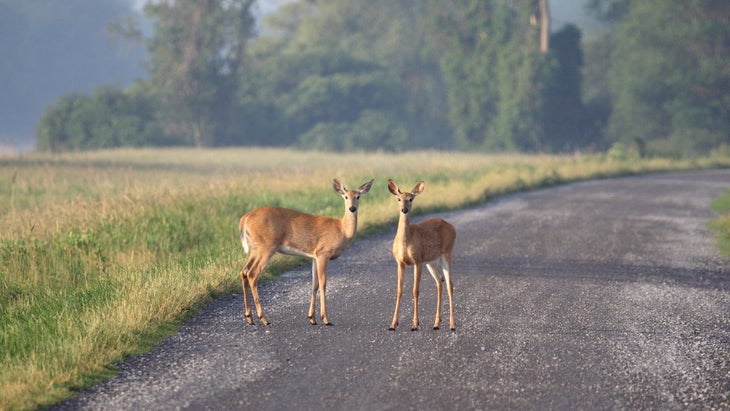
Birding options abound at Montezuma National Wildlife Refuge. This nearly 10,000-acre sanctuary, a smattering of marsh, forest, shrub, and grassland, is located along one of the Atlantic flyway’s most active paths, frequented by over 240 bird species. It’s also home to six active bald eagle nests.
The one-mile Seneca Trail Loop has an observation tower and a viewing platform perfect for spotting migrating songbirds, woodpeckers, and cerulean warblers. Walking trails along Esker Brook and South Spring Pool offer opportunities to see migrating songbirds, woodpeckers, and waterfowl. And the three-mile Wildlife Drive winds through dense animal habitat, with heron, Canada geese, bald eagle, muskrat, fox, and coyote sightings possible along the way. This route is open for walking and bicycling during summer.
Need to know: Walking trails are closed in late fall during New York State’s late deer bowhunting season.
Getting here: Head 34 miles north (about 40 minutes) along New York 89 North from Taughannock Falls State Park to reach Montezuma National Wildlife Refuge, located right on Route 20. The refuge’s visitor center and Seneca Trail access are just north of Route 20, via the Montezuma Entrance Road. The entrance road also connects with the Wildlife Drive.
Stop 8: Frontenac Island
Frontenac Island, on Cayuga Lake, is one of only two islands in the Finger Lakes. The two-square-mile island lies in the northeast portion of the lake, just half a mile from Frontenac Park, where kayak launches and boat rentals offer the best chance for visiting. While attractions are sparse on this off-the-beaten-path island, it’s the history that intrigues most visitors: parts of it were used as ancient burial sites for Native Americans, with records dating back 5,000 years. Before heading out, learn about this sacred history through the Frontenac Historical Society and Museum’s dedicated island exhibit.
Getting here: To get from Montezuma National Wildlife Refuge to Frontenac Park, head south from Route 20 nine miles via New York 90 South, then turn right on Green Street. Frontenac Island is roughly half a mile from the park shore. If you don’t have your own boat, rent one with FLX Marine in Frontenac Park. Kayak launch sites are available at Frontenac Park as well.
Stop 9: Skaneateles Lake
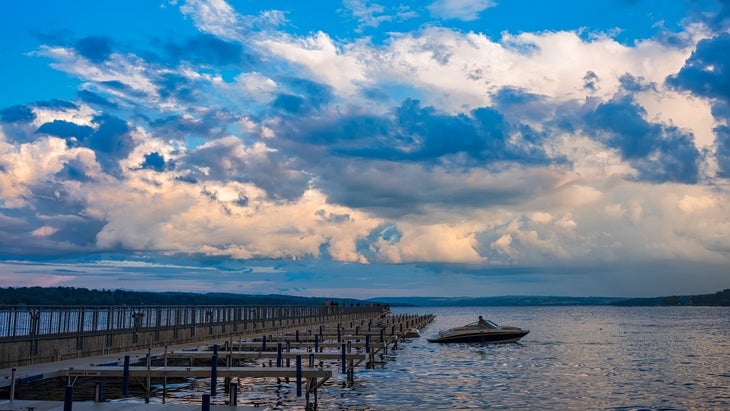
Skaneateles Lake’s clear cerulean water—the cleanest water in the Finger Lakes—is best explored by paddle, with public launch sites bookending the lake’s north and south. Local outfitter North End Outdoors specializes in Skaneateles Lake excursions; tours include traditional stand-up paddleboard outings, SUP yoga, and paddle parties for larger groups. Skaneateles Marina, on the lake’s western side, rents out kayaks and stand-up pedal and paddleboards, and pontoon boats.
Anglers can enjoy ample fishing here, particularly at the northern and southern tips, where shallow waters attract trout, yellow perch, and Atlantic salmon. Local outfitter Markin Fishing Charter leads anglers to Skaneateles’s top fishing spots; fish cleaning is included with the cost of each tour.
Need to know: Accommodation options abound at Skaneateles Lake, with low-key cabins via Finger Lakes Lodging and the hip Sherwood Inn (from $260) on the lake’s northern end.
Getting here: Frontenac Park to the north end of Skaneateles Lake is a 32-minute drive. Take New York 90 North to follow New York 326 East before joining Route 20, which intersects with the top of the lake. North End Outdoors tours start near the gazebo in Clift Park, right along Route 20. To reach the launch site for Markin Fishing Charter and Skaneateles Marina, turn right on New York 41A/ Kane Avenue before reaching the town of Skaneateles. The boat launch for fishing charters is three miles down New York 41A; Skaneateles Marina is four more miles down New York 41A.
The post The Ultimate Road-Trip Guide to New York’s Finger Lakes appeared first on Outside Online.
by eriley via Outside Online
Comments